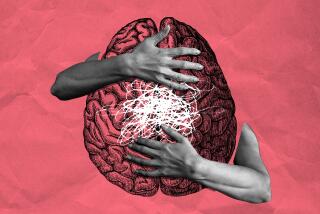Can a mouse meditate? Why these researchers want to find out
- Share via
Can a mouse meditate? A new study suggests the answer is ... kind of.
Researchers from the University of Oregon in Eugene have figured out a way to get the brains of mice to replicate some of the same patterns seen in the brains of meditating humans — no tiny cushions, incense or squeaky “oms” required.
The experiments show that the “meditating” mice were more relaxed and less stressed than controls who got no rodent meditation training.
The authors say the work, published this week in PNAS, provides a proof of concept that will allow them to learn more about how meditation affects the brain.
Previous research has shown that just one month of mindful meditation can have a significant impact on humans, both physically and psychologically.
It reduces self-reported anxiety and decreases the amount of the stress hormone cortisol in the blood.
Imaging studies of meditators’ brains have detected increased activity in the anterior cingulate cortex, or ACC. This area of the brain is involved in a wide variety of functions, including emotional regulation and cognitive control.
Scientists have also seen an increase in white matter around the ACC of people who meditate. That’s important because white matter serves as a kind of insulator, enabling electrical impulses to move more easily between neurons.
Although scientists have observed these positive physical effects of meditation on the human brain, they still don’t know what causes them.
“We think of meditation as a human thing, a high-level thing, but we want to examine the low-level biology of it,” said Cris Niell, a neuroscientist at the University of Oregon who helped lead the study.
The team’s first step in this quest was to create a mouse model that could replicate a human meditator’s brain.
They called it, jokingly, the mouse meditation project.
Training mice to focus on the breath, or to spend 20 minutes lying perfectly still for a body scan, was obviously out of the question. But the scientists had another plan.
Michael Posner, a psychologist at the University of Oregon, had shown in earlier work that another effect of meditation in humans was a change in the rhythms of the brain. Specifically, he found that particular oscillations near the ACC became “louder” after a meditation session.
“Everyone has these oscillations in their ACC, but they are stronger and more powerful in people after they do meditation,” said Aldis Weible, a researcher at the University of Oregon’s Institute of Neuroscience and the first author on the new study.
The authors knew they couldn’t get mice to meditate in a traditional way, but they wondered if they could make a mouse’s ACC oscillate in the same rhythm as a human meditator’s.
To do this, they genetically engineered mice to give them a special protein in their brains that causes neurons to fire when they are exposed to light. The researchers were able to insert the genetic code for these proteins exclusively in the neurons of the ACC.
Next, they connected a light source to the brains of the genetically engineered mice. By flashing the light in a specific pattern, they were able to make the ACC neurons fire at the same pace that they saw in human meditators.
“We are not necessarily making the mice meditate, but we are changing the pattern of activity in the brain region,” Niell said.
Tests revealed that mice that were exposed to the same patterns exhibited by human meditators were more relaxed than those that did not get the “meditation” treatment.
When placed in a box that had a dark side and a light side, the meditating mice were more likely than control mice to explore the light side, and to rear up on their little hind legs and look around.
Both these behaviors indicate a de-stressed mouse and suggest that the behavioral effects of meditation in humans can be re-created in rodents.
The authors also experimented with getting the ACC to oscillate at different frequencies, but they saw the most calming effects when the mouse brain was set to oscillate at the same rate as a human meditator’s brain — about eight times per second.
Niell said the work is significant because it gives researchers a scientific tool to study how meditation works in the brain, and it suggests that periodic stimulation could be used to effect change in the brains of people who don’t want to meditate.
The researchers wonder if a similar protocol could be used someday to help people recover from stroke or post-traumatic stress disorder more rapidly.
“This first publication is a proof of principle,” Niell said. “But hopefully in six months or a year, I’ll be talking to you about what it is that actually changes in the brain as a result of meditation.”
Do you love science? I do! Follow me @DeborahNetburn and “like” Los Angeles Times Science & Health on Facebook.
MORE IN SCIENCE
NASA’s Dawn mission finds life’s building blocks on dwarf planet Ceres
‘Extraordinary levels’ of pollution have contaminated even the deepest parts of the Pacific Ocean







